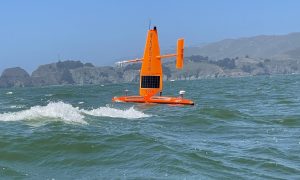Tropical Pacific Observing System 2021 Saildrone Mission Launched

As the western U.S. experiences record shattering heat waves and mega droughts and the eastern tropical Pacific started its 2021 hurricane season with the earliest tropical storm (Andres) on record going back to the early 1970s, two Uncrewed Surface Vehicle (USV) saildrones were launched on July 23, 2021 from Alameda, CA to the eastern tropical Pacific.
The eastern tropical Pacific is a key region for hurricane genesis and El Niño Southern Oscillation (ENSO) development. The ENSO cycle not only modulates hurricane genesis in the eastern tropical Pacific and the tropical Atlantic, but also affects the global marine ecosystem and weather patterns on land. The hurricanes and tropical cyclones (TCs) generated in the eastern tropical Pacific, whether or not they make landfall, control the critical source of moisture for rainfall, especially over western North America. This region, however, is a gap in the Tropical Pacific Observing System (TPOS).
The two saildrones enroute to the eastern tropical Pacific, will test how USVs may be used to address gaps in the present TPOS. The 150-day mission will target several phenomena including: (1) Air-sea interactions and convective development in the eastern Pacific hurricane genesis region; (2) Air-sea interactions, including CO2 outgassing, in the equatorial upwelling zone; (3) Wind convergence in the southeastern Inter-Tropical Convergence Zone (ITCZ) between 2S and 5S, often referred to as “the double ITCZ” region due to common biases of this phenomenon in models; (4) Air-sea interactions in the frontal zone north of the cold equatorial upwelling; and (5) Contrasting subtropical and tropical oceanic and atmospheric states in the eastern Pacific.
The mission is funded in part by NOAA Office of Marine and Aviation Operations (OMAO), NOAA Global Ocean Monitoring and Observing (GOMO), and NOAA National Oceanographic Partnership Program (NOPP), which brings partners together from different NOAA line offices, universities, and industry, along with international partners from both Mexico and France.
Read more about the mission on PMEL’s Ocean Climate Stations page.
